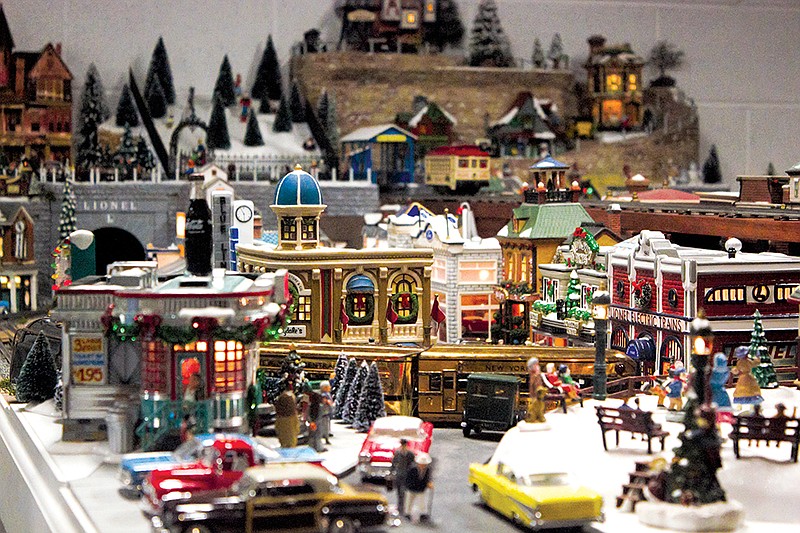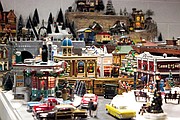In the basement of Ron DeJong's Ooltewah home is a vast, miniature world, a bygone era frozen in time -- at least until DeJong flips a switch.
Then, the 1950s come alive again. It's Christmastime in small-town America. The shoe-box-sized storefronts, draped with garland, light up; the fluorescent diner marquee blinks red; thumb-sized townspeople skate circles on a glass rink. The soul of the setup, a copper gold-plated New York Central passenger train, departs the depot and follows the track around the town, an endless loop of memories for the men who stand and watch.
Each month, local members of the Train Collectors Association meet up to talk trains and admire each other's setup -- almost always located in the rotating host's basement. The TCA is one of the largest collecting societies in the world, with nearly 30,000 members. The Chattanooga chapter has around 22, mostly retired men in their 70s and 80s, who remember the toys from their youth.
Throughout the 1950s, electric trains were at the peak of their popularity. Considered engineering marvels, the miniature replicas were powered by a tiny motor controlled through wires on the underside of the track. Back then, Lionel brand reigned supreme, and DeJong has hundreds of their models stacked in boxes throughout his basement.
But that copper-gold one featured in his elaborate setup is a Marx train, the very one he owned as a child -- he's almost certain.
When DeJong left for the navy in the 1960s, his parents moved, but first, they cleaned out his old toy boxes. When he returned home, he was upset to find the train was gone. He tried to track it down, visiting yard sales and auctions -- where he found it once but was outbid by a dealer.
During that time, DeJong became a model train hobbyist, finding new models and accessories to add to his collection. Then, 23 years after he'd returned home from the navy, an identical copper gold-plated New York Central train went up for sale near where he grew up.
Finally, he bought it back for $150.
The model is rare, DeJong says, but it's not a high-end collector's item, which can go for thousands of dollars depending on the condition. Marx brand trains, he explains, were more affordable than Lionel, as they lacked the realistic fine detailing.
The real value for DeJong and all the men with whom he gathers each month is sentimental.
"When I look at trains, I think of my dad," says Gerald Jackson, president of TCA's Chattanooga chapter. At age 4, his father gave him a six-car Lionel train, which he still has in his East Ridge basement, a room devoted entirely to his hobby.
All four walls are lined from floor to ceiling with model trains -- a total of 1,500, he says. The spaces also features a 14-by-28-foot table transformed into a sprawling city. An electric Lionel Union Pacific steam engine hauling 23 cars loops its perimeter, encircling a busy commercial strip: miniature banks; car washes; gas stations; a Mel's Drive-In diner where a tiny woman roller skates up to a black 1957 Chevrolet and asks to take their food order -- motorized movements and sound that Jackson, a retired computer engineer, controls through an app on his phone.
The strip is lined with postcard-sized billboards and a sign welcoming all to the city of "Lionelville, home of Jocko Sporting Goods Co."
Jackson's original Lionel engine is displayed on one of the shelves, and across the room, another row of shelves holds a series of other engines, also gifts from his father.
"I got a new engine every Christmas for good grades," he says. "My dad said it was for me, but really it was for him."
While other boys his age were out romping through the neighborhood, "I was under the table working on wiring trains," he says. Meanwhile, his father was building paper mache mountains around their basement furnace, sculpted tunnels at their base through which the train could pass.
Model train collectors do more than collect. They do more than learn basic electrical skills to power all the moving accessories, which is his favorite part, says Jackson, who graduated as high school valedictorian.
The hobby also often requires carpentry skills to custom-build plywood tables, as well as an understanding of mechanics to maintain the vintage toys. But more than anything, the men agree, it requires imagination and creativity.
"It's funny looking back," says Chattanooga chapter member Bob Gillen, "we had no idea [my dad] had such artistic talent until we got the train."
He remembers the intricate skylines painted by his father almost as vividly as he remembers his hometown of Pittsburgh, Pennsylvania. From his window, he could see the Allegheny River and far in the distance, the Pennsylvania Railroad, which always fascinated him.
As a child, his family would take trips on Pennsylvania's Broadway Limited passenger train, following the Main Line from Pittsburgh to Philadelphia to Ocean City. The trip required overnight travel, which meant they'd stay in a sleeper car.
But Gillen says he never slept. He was too excited, so he'd stay up all night to watch the scenery from the window: a blur of passing color and memory, the fleeting wonder of childhood, a feeling he's spent the rest of his life trying to rebuild.

